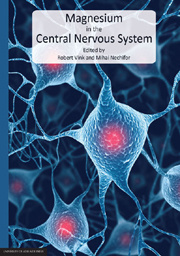Book contents
- Frontmatter
- List of Contributors
- Preface
- Contents
- Section 1 Magnesium in Normal Brain
- Chapter 1 Free magnesium concentration in human brain
- Chapter 2 Intracellular magnesium homeostasis
- Chapter 3 Magnesium transport across the blood-brain barriers
- Chapter 4 Intracellular free Mg2+ and MgATP2− in coordinate control of protein synthesis and cell proliferation
- Chapter 5 Magnesium and the Yin-Yang interplay in apoptosis
- Chapter 6 Brain magnesium homeostasis as a target for reducing cognitive ageing
- Section 2 Magnesium in Neurological Diseases
- Section 3 Involvement of Magnesium in Psychiatric Diseases
Chapter 3 - Magnesium transport across the blood-brain barriers
from Section 1 - Magnesium in Normal Brain
Published online by Cambridge University Press: 05 June 2012
- Frontmatter
- List of Contributors
- Preface
- Contents
- Section 1 Magnesium in Normal Brain
- Chapter 1 Free magnesium concentration in human brain
- Chapter 2 Intracellular magnesium homeostasis
- Chapter 3 Magnesium transport across the blood-brain barriers
- Chapter 4 Intracellular free Mg2+ and MgATP2− in coordinate control of protein synthesis and cell proliferation
- Chapter 5 Magnesium and the Yin-Yang interplay in apoptosis
- Chapter 6 Brain magnesium homeostasis as a target for reducing cognitive ageing
- Section 2 Magnesium in Neurological Diseases
- Section 3 Involvement of Magnesium in Psychiatric Diseases
Summary
Abstract
The finding that magnesium levels are reduced in acute and chronic brain diseases has led to a recent surge in interest in the role of magnesium in the normal and injured nervous system, although the mechanisms of magnesium decline in pathological conditions and its availability in the neural tissue after administration are not fully understood. The brain has two main barrier systems: (1) the blood-brain barrier (BBB) formed by brain capillary endothelial cells which separate the blood from the extracellular fluid in the neuropil; and (2) the blood-CSF barrier (BCSFB) formed by choroidal epithelial cells which separate the blood from the CSF. Genetic studies in families with hereditary hypomagnesemia have identified mutations in two genes encoding claudin-16 (paracellin-1) and claudin-19, both localized at tight junctions between nephron epithelial cells and providing passive paracellular conductance for magnesium in the kidney. Endothelial cells of the BBB also express claudins, although whether members of the claudin family expressed at the BBB and BCSFB have similar conductance for magnesium akin to the role of claudin-16 and -19 in the nephron remains to be confirmed. Recently, the transient receptor potential melastatin (TRPM) members TRPM6 and TRPM7 have been identified as cation channels for magnesium transport. Although it is not known if choroidal epithelial cells express TRPM6 and TRPM7, these molecules are expressed by brain endothelial cells and may play a role in magnesium transport. While it is evident that magnesium enters the CNS through the BBB and is actively transported by choroidal epithelial cells into the CSF, the mechanisms of its entry into the brain will require further investigation.
- Type
- Chapter
- Information
- Magnesium in the Central Nervous System , pp. 59 - 74Publisher: The University of Adelaide PressPrint publication year: 2011
- 8
- Cited by



